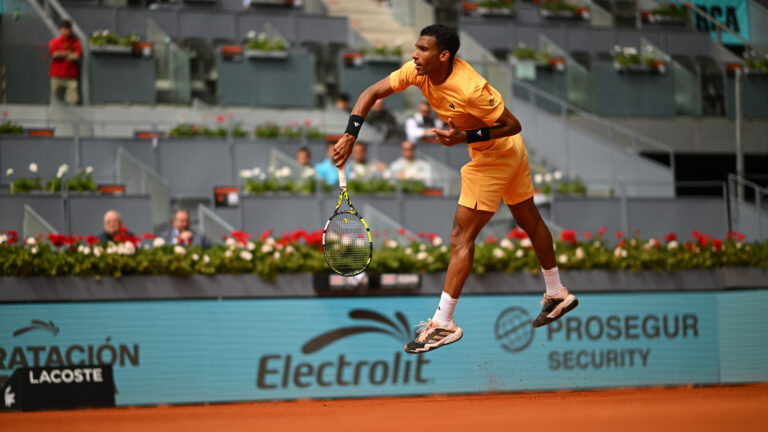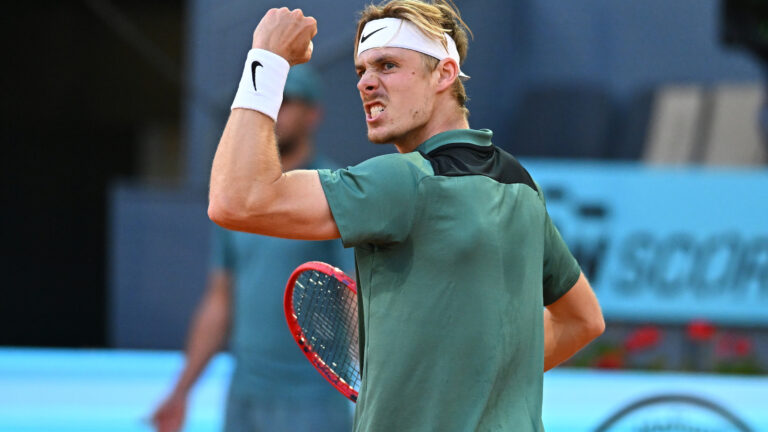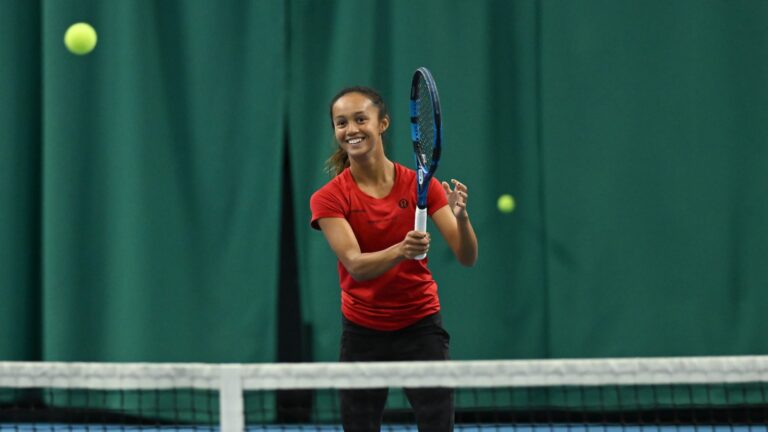TEBBUTT: SHOWTIME IN PARIS

Roland Garros is an annual rite of the French sporting and social calendars and remains popular despite Mary Pierce – Montreal-born and American-raised – in 2000 being the last French winner of either the women’s or the men’s titles.
Before that, Yannick Noah in 1983 and Francoise Durr in 1967, were the most recent winners from the host country.
The two players pictured above – Richard Gasquet and Gael Monfils – both victorious in their matches on Thursday, are decided long shots to win the singles title this year.

Mauricio Paiz
Rafael Nadal, eight times a winner on the Parisian red clay, and Novak Djokovic, winner of his last four matches against Nadal, remain the logical picks to be the 2014 champion.
With the exception of Stan Wawrinka, ousted on the second day by Guillermo Garcia-Lopez, all the main contenders remain and it will be a surprise if anyone other than the current No. 1 and No. 2 in the world winds up with the Coupe des Mousquetaires on Sunday, June 8.
The ouster of Wawrinka opened room for Andy Murray to get to his second semifinal (2011) at Roland Garros and a manageable list of potential opponents means that Roger Federer could reach his eighth semifinal, including the year he won the title in 2009.
David Ferrer, destined for a quarter-final with Nadal and a re-match of last year’s final, is a well-known commodity in any contemporary clay-court event. And there are more unlikely but not totally improbable challengers such as Milos Raonic, in Djokovic’s quarter, and the volatile Latvian, Ernests Gulbis, who could meet Federer in the round-of-16 if both win their matches on Friday.
But the men’s event is probably not as wide-open as the women’s tournament after the dramatic 6-2, 6-2 loss to by top seed and defending champion Serena Williams to Garbine Muguruza on Wednesday.
Is it age – 33 in September, is it a mysterious ailment or is it something in her personal life, whatever it was it’s difficult to imagine Williams playing much worse or looking less inspired at a Grand Slam event.
The fallout from the Williams loss, as well as the exit of No. 2 seed Li Na has removed a two-time (2002 and 2013) and a one-time (2011) champion respectively from the hunt for the title.

Mauricio Paiz
As a result, there are some serious openings in the draw, particularly in the bottom half where No. 4 seed Simona Halep (above) may be favoured to reach the final. There are some odd groupings inside the various quarters – i.e. Grand Slam champions Petra Kvitova, Svetlana Kuznetsova and Ana Ivanovic (as well as Lucie Safarova) together in one foursome while the quartet just below them is made up of Sloane Stephens, Ekaterina Makarova, Maria-Teresa Torro-Flor and Halep.
Another grouping in the top quarter of the top half has Muguruza, Anna Schmiedlova, Pauline Parmentier and Mona Barthel – with only one Grand Slam round-of-16 among them – playing off to meet one of Dominika Cibulkova, Samantha Stosur, Maria Sharapova (11 total Grand Slam final appearances among them) or No. 75-ranked Paula Ormaechea of Argentina in the quarter-finals.
As much as it’s unbalanced, it creates great opportunities for a player or two to make their marks at a Grand Slam.
Canada’s Eugenie Bouchard did not benefit from quite the same good fortune as some of the lesser-lights mentioned above, but in terms of real form players, the only names remaining who would be major obstacles to a spot for her in the semifinals are No. 3 seed Agnieszka Radwanska and No. 14 Carla Suarez Navarro – and that wouldn’t be until the quarter-finals. Johanna Larsson in Friday’s third round is about as beatable an opponent as Bouchard could hope for at this stage of the event.
Besides 2012 winner Sharapova, there are only two remaining former champions in the field – Kuznetsova (2009) and Ivanovic (2008).
With Williams and Li out, and a promising bunch of young talents emerging, this would appear to be a golden opportunity for any of them to become a two-time French Open winner.
A final note – each year everyone is all gloom and doom about the rainy weather for the first week of Roland Garros. Well, guess what? Despite cool, damp, rainy days – the tournament is right on schedule after its first five days. It says something about how clay courts absorb water. Similar precipitation at Wimbledon on the grass would have considerably backed up the tournament.
NESTOR INTO ROUND THREE

With nine days left before the men’s doubles final on Saturday, June 7, Daniel Nestor and partner Nenad Zimonjic have already played two of the six matches they will need to win a second Roland Garros title (2010) together – a fifth for Nestor alone.
On Thursday, Nestor and Zimonjic beat Igor Sijsling and Roberto Bautista Agut 6-3, 6-7(5), 6-3 to move into the round-of 16.

Zimonjic stole the show on the final two points of the vital break of the Bautista Agut serve midway through the final set with a huge backhand that blew by the Dutch-Spanish pair and then put away a backhand volley to seal the break.
“Those guys are good players,” Nestor said. “If you let them hang around, they’ll start playing well.”
Next for him and Zimonjic, seeded third, will be the 13th seeds, Horia Tecau of Romania and Jean-Julien Rojer of the Netherlands.

Gabriela Dabrowski and her partner Alicja Rosolska of Poland were happy winners over Ajla Tomljanovic of Croatia and Shuai Zhang of China in a first–round women’s doubles match on Thursday. They won by the convincing score of 6-1, 6-3.
“I’ve practiced with Ajla before and have played against Zhang,” Dabrowski said, “and we were confident because they are not a traditional doubles pair. We had decided that we would do a lot of crossing.”
It was the first win in a Grand Slam event for the 22-year-old Dabrowski and she and Rosolska will next face fifth-seeded Cara Black and Sania Mirza.

And does anybody get lower than Dabrowski when her partner is serving?
RAONIC AND BOUCHARD ON THE MARQUEE

Milos Raonic will make his Court Philippe Chatrier debut on Friday against Gilles Simon. It should be a raucous affair as it is scheduled in the late afternoon when the ‘tribunes’ fill up with Parisians in a good mood as they begin ‘le weekend.’
Both players – Raonic seeded No. 8 and Simon at No. 29 – come in playing well. Raonic won their only previous encounter, in Estoril, Portugal, on clay 7-6(1), 6-7(4), 6-2 in 2011.
Simon, who has been known to play long, drawn-out matches, enters the third-round clash having won his first two matches in straight sets – only the second time he has done that in 31 Grand Slam appearances.
To prepare for the daunting Raonic serve, which he considers to be the best in tennis, Simon practiced on Thursday with 6-foot-8 Jerzy Janowicz.
Raonic is in the most impressive form of his career and is clearly the favourite, but Simon is a fine tactician and dogged competitor who will attempt to extend the match, calculating that the longer it lasts, the greater the chances will be that he will win.

Eugenie Bouchard has gone from Court 5 (Monday) to Court 7 (Wednesday) and now Court 2 (Friday) for her third match of the 2014 French Open against Johanna Larsson of Sweden.
At 1,445 capacity, Court 2 is actually slightly smaller than Court 7 where she beat Julia Goerges on Wednesday, but it’s a permanent structure and has been the site of many memorable matches in the storied history of Roland Garros.
The match is ‘fourth on’ and should start in the late afternoon.
Larsson, who possesses a good kick serve a la Sam Stosur, ranks No. 99 and has never really made a name for herself in the big leagues of tennis. But she did have one exciting match at Roland Garros – in 2011 she stretched Ana Ivanovic to 7-6(3), 0-6, 6-2 in the opening round on Court Suzanne Lenglen.
It will probably take that strong a performance for her to unsettle Bouchard. The Swede’s record thus far in 2014 is 5-4 while Bouchard is 27-11.
L’EQUIPE IS THE LAST WORD

For many years, the French sporting daily L’Equipe has been the last word in Roland Garros coverage, as well as the last word in tennis coverage around the world.
It has had the most dedicated and informed group of tennis writers anywhere and really pumps up its coverage during the French Open.
But things have changed and the ‘chapeau,’ or main daily resumé piece, is no longer a part of the section during Roland Garros. And the number of pages has diminished from as many as seven or eight to four.
Denis Lalanne starting in the 1960s, and then followed by Philippe Bouin from the 1990s until 2010, authored the daily ‘chapeau’ with insight, wit and a broad knowledge that was a treat to read.
Lalanne, now 88, was at Roland Garros on Tuesday to award the ‘Prix Denis Lalanne’ for the best tennis story of 2013 to L’Equipe’s Frédéric Bernes.
He also did an interview with the Roland Garros ‘Quotidien’ (Daily) and said the following when asked about what Roland Garros was like in the 40 years he covered the tournament from the 1950s to the 1990s. “The place used to be like a walk in the park – like a Sunday in the country,” Lalanne said. “You used to be able to get your friends, or your girlfriend, in without any problems. In 1958, my wife would wander around the walkways peacefully with a baby carriage while I was watching matches. It was another world – regarding the players as well. At the time, I admired Budge Patty, an American who lived in Paris and dressed in cashmere. His class was off the charts.”
This year, L’Equipe got a bit unlucky with its selection of the cover story (at top) for the June issue of its ‘Journal de Tennis.’ It chose reigning Australian Open champion Stan Wawinka, who was unceremoniously bounced in the first round by Guillermo Garcia Lopez.
PARIS POST CARD

In the promenade between Court Philippe Chatrier and Court Suzanne Lenglen on Thursday, a Roland Garros worker/photographer was offering free photos. The above mother and son were happy to allow him to do his job.


